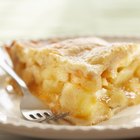vikif/iStock/GettyImages
Both cornstarch and flour are grain starches suitable for thickening sauces, soups, gravies, puddings and pie fillings. While flour works best when mixed with a fat, cornstarch thickens right away with little heat and twice the thickening power. Made from the endosperm of the corn kernel, cornstarch can be used instead of flour as a thickener or as a coating for meat or fish, but it's not a substitute in equal parts to flour when baking .
Preparing the Cornstarch
Cornstarch will turn lumpy if you add it directly to a hot sauce, so first add the cornstarch to cold water. Use a jar with a tight-fitting lid, add a few tablespoons of water and shake the jar until the lumps are broken and the water turns milky. Unlike some thickeners, cornstarch blends well with dairy and is a good choice for thickening cream-based soups and sauces. The only drawback is that dishes thickened with cornstarch can turn spongy if frozen, thawed and re-heated.
Thickening the Dish
Unlike flour, cornstarch does not tolerate heat well. For best results, add cornstarch to your soup, sauce or gravy at the end of cooking. Bring your dish to a boil first, then stir in the cornstarch blended with the liquid directly into the pot. Keep stirring until the soup or sauce starts to coat the spoon. As soon as it thickens, reduce the heat to low or remove from the burner and serve. Cornstarch will lose its thickening power if over-heated, and it's not as effective when thickening acidic sauces such as those made with tomatoes or lemon juice.
Making Pies and Puddings
When substituted for flour as a thickener for desserts like puddings and pie fillings, cornstarch is at its best. Neutral tasting and strong-acting even in small amounts, cornstarch imparts a low-gloss shine, making your desserts even more appetizing. To substitute cornstarch for flour, use half the amount of cornstarch than you would of flour in your dish. If making a pudding, add the cornstarch to the end of your cooking, first blending it with cold water; cornstarch thickens right away.
Coating the Meat
Dredging raw chicken or fish in a little cornstarch or flour before dipping it in an egg wash and breading helps the coating stick to the meat, sealing in the juices and adding texture. Cornstarch can be substituted in equal parts for flour in these preparations. Use it by itself as a gluten-free coating for meat; it helps the browning process and adds flavor since any herbs or seasonings you blend with the cornstarch will stick to the meat. Simply place enough cornstarch to coat your meat in a shallow bowl or pie plate; add seasonings and turn the meat on both sides to coat.
Related Articles

What Can I Substitute for Cornstarch?

Adding Corn Starch to a Pot Roast
What Can I Substitute for Cornstarch?

Corn Starch Vs. Rice Flour As ...

Can I Use Baking Powder to Thicken ...

How to Use Cornstarch to Make Breaded ...

Substitute for Manioc Starch

Can You Use Konjac Flour in Baking?

Substitute for Vanilla Custard Powder

How to Substitute Cornstarch for ...

Do You Use Flour or Corn Starch to ...

Can You Use Flour to Thicken Chili?

Can You Make Dumplings With Cornstarch?

Can You Use Matzo Flour to Thicken ...

Can You Coat Meat With Corn Starch?

Can You Thicken Soup With Xanthan Gum?

What Is Ratio for Cornstarch & Water to ...

How to Substitute Cornstarch for ...

How to Cook Luglug Cornstarch Noodles

Recipes for Enameled Cast Iron Cookery
References
Resources
Writer Bio
For more than 10 years, Carol Butler has run a small, off-grid furniture business with her husband and is a regular contributor to the Edible community of magazines. As staff writer for RichLife Advisors, she covers financial planning and other industry-related topics. She holds a B.F.A. in theater arts.